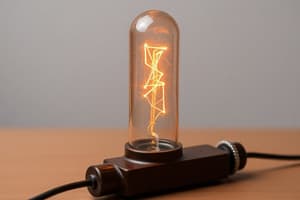Podcast
Questions and Answers
According to Thomson's Model of an Atom, what did he compare the electrons to?
According to Thomson's Model of an Atom, what did he compare the electrons to?
- Black seeds in a watermelon (correct)
- Red edible part of a watermelon
- Christmas pudding
- Alpha particles
What is the charge of an electron?
What is the charge of an electron?
- Neutral
- Negative (correct)
- Variable
- Positive
What type of particles does radioactivity involve giving out?
What type of particles does radioactivity involve giving out?
- Electrons and photons
- Positive and negative particles
- Alpha and beta particles (correct)
- Protons and neutrons
In Rutherford's Experiment, what particles were used and directed towards a thin gold foil?
In Rutherford's Experiment, what particles were used and directed towards a thin gold foil?
What did Rutherford conclude about the distribution of positive charge in an atom?
What did Rutherford conclude about the distribution of positive charge in an atom?
What was one of the major observations from the Gold Foil Experiment?
What was one of the major observations from the Gold Foil Experiment?
Why did Rutherford's model of the atom face a drawback according to the text?
Why did Rutherford's model of the atom face a drawback according to the text?
What was the purpose of Millikan's Oil Drop Experiment?
What was the purpose of Millikan's Oil Drop Experiment?
According to Bohr's model, where do electrons revolve around in an atom?
According to Bohr's model, where do electrons revolve around in an atom?
What did Rutherford conclude about the size of the nucleus compared to the overall size of an atom?
What did Rutherford conclude about the size of the nucleus compared to the overall size of an atom?
What were the major observations made by Rutherford in the Gold Foil Experiment and what conclusions did he draw from them?
What were the major observations made by Rutherford in the Gold Foil Experiment and what conclusions did he draw from them?
Explain the drawbacks of Rutherford's model of the atom and how Bohr's model addressed these drawbacks.
Explain the drawbacks of Rutherford's model of the atom and how Bohr's model addressed these drawbacks.
Describe the significance of Millikan's Oil Drop Experiment and what conclusion was drawn regarding the charge of an electron from this experiment?
Describe the significance of Millikan's Oil Drop Experiment and what conclusion was drawn regarding the charge of an electron from this experiment?
Flashcards are hidden until you start studying
Study Notes
Sub-Atomic Particles
- Electrons are negatively charged sub-atomic particles of an atom with a negligible mass and a charge of -1, symbolized as e–.
- Electrons are extremely small and found outside the nucleus.
Thomson's Model of an Atom
- According to Thomson, an atom consists of a positively charged sphere with electrons embedded in it.
- The negative and positive charges are equal in magnitude, making the atom electrically neutral as a whole.
- Thomson's model is often compared to a Christmas pudding or watermelon, where the positive charge is the edible part and the electrons are the seeds.
Radioactivity
- Radioactivity is the process by which an unstable nucleus loses energy by emitting particles such as alpha and beta particles.
- This process occurs spontaneously due to an imbalance in the protons and neutrons in the nucleus, making the atom unstable.
Rutherford's Experiment and Observations
- Rutherford's experiment involved bombarding a thin gold foil with fast-moving alpha particles to study the structure of the atom.
Studying That Suits You
Use AI to generate personalized quizzes and flashcards to suit your learning preferences.



